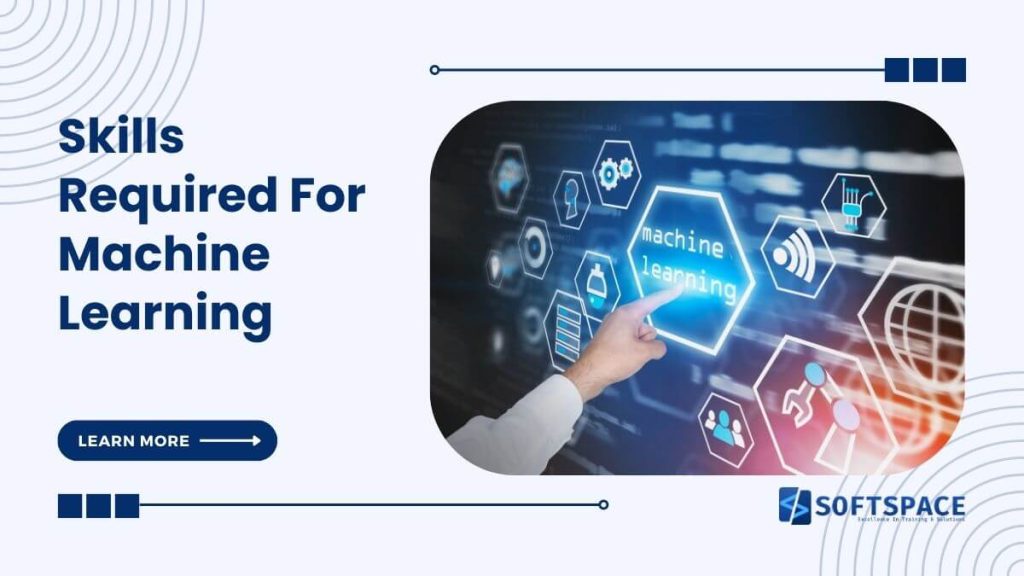Are you interested in pursuing a career in machine learning? Or are you looking for the skills required for Machine Learning opportunities? Look no further! In this blog post, we’ll cover the essential skills you need to master to become a successful machine learning practitioner.
From programming languages to statistical analysis and data visualization, we’ll explore the critical skills that will help you build and train accurate machine-learning models. We’ll also discuss the importance of understanding data structures and algorithms, and how to apply them effectively in real-world scenarios.
Moreover, we’ll delve into the soft skills that are just as crucial in machine learning, including communication, problem-solving, and teamwork. You’ll learn why having a growth mindset and the ability to learn quickly are essential traits for any machine learning practitioner.
Whether you’re just starting in machine learning or looking to advance your skills, this blog post about the 15 skills required for machine learning is for you. So, buckle up, and let’s dive into the world of machine learning together!
Table of Contents
What is Machine Learning?
The concept of machine learning revolves around using data to teach machines how to predict and make decisions. This process is divided into three fundamental steps: data preparation, model training, and model evaluation.
During data preparation, the accuracy, completeness, and relevance of data are ensured by collecting and cleaning it to fit the specific problem.
The next step involves training the machine learning model using the data, wherein the model essentially becomes a mathematical algorithm that can recognize patterns and provide predictions based on such patterns. Finally, the model must be thoroughly evaluated for accuracy and reliability.
One of the most fascinating aspects of machine learning technology is its ability to solve incredibly complex problems that are beyond human capabilities. For example, consider the scenario where we require a machine to identify faces in a large crowd.
Though humans have no difficulty doing so, teaching a computer to perform such a task would be extremely challenging, if not impossible. However, with machine learning, we can train the model to identify faces, based on patterns in the data. This enables the model to recognize faces much faster and with greater accuracy than any human possibly can.
Skills Required For Machine Learning: Unpacking the Essentials
Without a doubt, machine learning has become one of the most sought-after fields in technology. From healthcare to finance and even e-commerce, machine learning is making significant contributions to the way we live and do business.
To become an expert in machine learning, you need more than just a basic understanding of the principles behind the technology.
A combination of technical and non-technical skills is required to succeed in the field. In this blog, we will dive deep into the skills required to become a machine learning professional, explore real-life examples, and share some statistics on the current state of the industry.
Technical Skills: The Foundation of Machine Learning
Programming Skills
Python: Python is a versatile and widely used programming language in the field of machine learning. You’ll need to be proficient in Python to write code for data manipulation, model building, and data analysis. Many libraries and frameworks used in machine learning, such as NumPy, scikit-learn, and TensorFlow, are available in Python.
Mathematics
Linear Algebra: Linear algebra involves understanding concepts like matrices, vectors, and operations on them. This knowledge is crucial for tasks like transforming data and performing matrix operations in machine learning algorithms.
Calculus: Calculus is important for understanding optimization algorithms used in machine learning, such as gradient descent. It helps you find the minimum or maximum of functions, which is central to training models.
Probability and Statistics: Probability and statistics are fundamental for tasks like estimating probabilities, calculating expectations, and handling uncertainty in data. You’ll use these concepts for hypothesis testing, probability distributions, and statistical analysis.
Machine Learning Algorithms
This involves knowing the various types of machine learning algorithms, including supervised learning (where the model learns from labeled data), unsupervised learning (where it finds patterns in unlabeled data), and reinforcement learning (where agents learn through interaction with an environment). Understanding how different algorithms work and when to use them is essential.
Data Preprocessing
Data preprocessing is the process of cleaning and organizing data before feeding it into machine learning models. This includes tasks like handling missing data, normalizing or scaling features, and performing feature engineering to create new features that might improve model performance.
Data Analysis
Data analysis is another crucial skill required in Machine Learning as it involves cleaning, exploring, and transforming raw data to create accurate models. Machine learning algorithms require high-quality data that can be organized and classified to give useful insights. You can refer to our Data Science course as well to get skilled in the profile.
Model Building and Evaluation
This involves creating machine learning models using data and assessing their performance. You’ll need to understand how to select the appropriate algorithms for your task, split data into training and testing sets, and evaluate the model’s performance using metrics like accuracy, precision, recall, or F1-score.
Deep Learning
Deep learning is a subset of machine learning that deals with neural networks, which are inspired by the human brain. To work in deep learning, you should be familiar with deep learning frameworks like TensorFlow and PyTorch, and understand concepts like artificial neural networks, convolutional neural networks (CNNs), and recurrent neural networks (RNNs).
Data Visualization
Data visualization is about representing data in graphical form to make it more understandable and insightful. Tools like Matplotlib, Seaborn, or Tableau can help you create visualizations that convey your findings effectively.
Feature Engineering
Feature engineering involves creating new features from existing data to improve model performance. It can include techniques like one-hot encoding, feature scaling, and extracting meaningful information from raw data.
Model Tuning and Optimization
Model tuning refers to the process of adjusting hyperparameters to optimize a machine learning model’s performance. Techniques like grid search or random search can help you find the best hyperparameters for your model.
Deployment Skills
Once you’ve built a machine learning model, you’ll need to deploy it in a production environment. This requires skills in containerization (e.g., Docker), cloud platforms (e.g., AWS, Azure), and web frameworks if your model is used in web applications.
Version Control
Version control, typically using Git, helps you track changes to your code and collaborate with other team members. It ensures code stability and facilitates project management.
Domain Knowledge
Understanding the specific industry or problem domain you’re working in is crucial. This knowledge helps you define problems, interpret results, and make models more relevant and effective.
Ethical Considerations
Understanding the ethical implications of your work is important. Be aware of biases in data, potential biases in models, and ethical issues in AI and machine learning.
Project Management
Effective project management skills help you plan, execute, and deliver machine learning projects on time and within budget. It involves setting goals, managing resources, and coordinating tasks.
Machine Learning Libraries and Frameworks
There are several machine learning libraries and frameworks available, each with its own unique features and capabilities. Here’s a list of some of the most popular ones:
- Scikit-learn: Scikit-learn is a versatile and easy-to-use library for traditional machine learning. It provides tools for classification, regression, clustering, dimensionality reduction, and model selection.
- TensorFlow: TensorFlow, developed by Google, is a powerful deep-learning framework that supports both traditional machine learning and deep neural networks. It’s widely used in various applications, including computer vision, natural language processing, and reinforcement learning.
- PyTorch: PyTorch is another popular deep learning framework known for its flexibility and dynamic computation graph. It’s favored by researchers and developers for its ease of use and strong community support.
- Keras: Keras is an open-source neural network library that is now integrated with TensorFlow. It offers a high-level, user-friendly API for building and training deep learning models.
- XGBoost: XGBoost is a highly efficient and scalable gradient-boosting library. It’s often used for structured data and is known for its excellent performance in various machine-learning competitions.
- LightGBM: LightGBM is another gradient-boosting framework developed by Microsoft. It’s known for its speed and efficiency and is used in many machine-learning projects for tasks like classification and regression.
- Pandas: While not a machine learning library, Pandas is a crucial data manipulation library for data preprocessing and analysis. It’s often used in conjunction with machine learning libraries.
- Numpy: NumPy is another foundational library that provides support for arrays and matrices. It’s an essential component for numerical computations in Python, often used in combination with other machine-learning libraries.
- Matplotlib: Matplotlib is a popular data visualization library in Python. It’s used to create various types of charts and graphs to visualize data and model results.
- Seaborn: Seaborn is a higher-level data visualization library built on top of Matplotlib. It simplifies the process of creating attractive and informative statistical graphics.
These libraries are valuable tools for machine learning practitioners and researchers, providing a range of options for various tasks, from data preprocessing and modeling to visualization and evaluation. Depending on your specific needs and preferences, you can choose the one that best suits your project.
Non-Technical Skills: The Soft Skills That Matter
Communication Skills
Communication is a key skill required in all areas of life, and machine learning is no exception. You need to be able to articulate your ideas and demonstrate how algorithms can be applied to real-life scenarios.
Being able to explain technical concepts in simple terms is essential when engaging with clients or colleagues who may not be familiar with the field.
Problem-solving Skills
Machine learning is all about problem-solving – from identifying data patterns to developing algorithms to solving technical challenges. A good machine learning professional will be able to think critically and creatively and have a deep understanding of the underlying principles.
Continuous Learning
Machine learning technology evolves rapidly, so machine learning professionals need to stay up-to-date with new tools, techniques, and algorithms. Machine learning professionals should actively explore new horizons, be curious, and embrace ongoing learning to keep pace with the ever-evolving industry.
Exploring the Boundless World of Machine Learning
In the rapidly evolving field of machine learning, staying up-to-date with the latest developments and advancements is crucial for any industry leader or data enthusiast. To help you get started, we’ve compiled a list of top examples in machine learning that are sure to inspire and educate.
AlphaGo
Developed by DeepMind Technologies, AlphaGo is a computational program that uses machine learning and artificial intelligence to play the board game Go. In 2016, AlphaGo made headlines when it defeated a world champion in the game, prompting further research into machine learning’s capabilities.
Tesla’s Autopilot
Tesla’s innovative Autopilot feature uses machine learning to analyze driving patterns and perform functions such as self-steering, automatic lane changes, and automatic emergency braking. This technology has the potential to revolutionize the transportation industry in the near future.
Amazon Go
Amazon’s futuristic brick-and-mortar store uses machine learning and computer vision to eliminate checkout lines. With the help of sensors and cameras, the store can detect which items are being taken off the shelves and automatically charge customers’ Amazon accounts.
Google Duplex
Google’s AI-powered virtual assistant, Duplex, is capable of holding conversations with humans in a natural and engaging manner. Duplex can book appointments or reservations on behalf of the user, and it adds a human-like touch to virtual assistants.
Deepfake
The term “deepfake” refers to AI-generated videos that are extremely lifelike and can be used to make false claims or spread misinformation. Although controversial, deepfake technology has the potential to be used in areas such as film production, where it could reduce costs and save time.
StyleGAN
StyleGAN is a machine-learning model that is capable of generating incredibly realistic images of people and animals. This technology could have a major impact on industries such as fashion, where it could be used to design clothing or create virtual models.
These examples are just the tip of the iceberg when it comes to the exciting possibilities of machine learning. With technology advancing at such a rapid pace, we can only imagine what groundbreaking developments await us in the near future. So why not stay ahead of the game and dive into the dynamic world of machine learning today?
From Data to Decisions: The Impact of Machine Learning
The influence of Machine Learning can be seen across various industries. One of the best examples of this can be seen in the entertainment sector, where the streaming giant, Netflix, uses Machine Learning to recommend TV shows and movies to users, based on their viewing history.
Similarly, Google uses Machine Learning to optimize ad placements for higher click-through rates, and Amazon uses it to power its product recommendations and Alexa.
Overall, it can be said that Machine Learning is rapidly transforming various industries by enabling better decision-making, increased efficiency, and automation. With more data being generated every day, there’s an ever-expanding need for Machine Learning-powered systems that can extract insights and add value to businesses.
Impact of Machine Learning: Statistics and Facts
With applications in several sectors, machine learning is a very intriguing and expanding science. You’ve come to the perfect site if you want to learn the skills required for machine learning and more about this fascinating area and the newest trends and ideas. Here are some machine-learning statistics and facts that are likely to catch your attention:
- The artificial intelligence and machine learning industry is anticipated to reach $3.9 billion globally by 2022, according to a recent Gartner analysis.
- Algorithms are now being employed in social media to evaluate user behavior, predict trends, and scrutinize sentiment. This is where machine learning is becoming more prevalent.
- In the finance industry, machine learning is expected to reduce fraud by 40% and increase revenue by 14%.
- Algorithms are being required to develop more realistic and captivating immersive gameplay in the gaming sector, which again relies on machine learning.
- By spotting and thwarting attacks in real-time, machine learning can be employed to boost cybersecurity.
- In the healthcare industry, machine learning is expected to reduce treatment costs by 50% and improve patient outcomes by 30%.
- In order to improve logistics and supply chain management, machine learning may also be used to analyze data on delivery times, inventory levels, and shipping prices.
- According to a recent report by McKinsey, AI and machine learning are expected to create between $3.5 and $5.8 trillion in value each year across industries.
- During the last five years, the number of job posts for machine learning-related roles has risen exponentially, reaching a more than 300% jump since 2015.
- From healthcare and finance to retail and transportation, machine learning has been implemented in a broad spectrum of sectors. Machine learning algorithms are employed within the healthcare sector, for instance, to anticipate healthcare patterns and recognize possible threats to health prior to having severe repercussions.
- By 2025, the self-driving car market is expected to be worth over $500 billion.
A rising number of applications and career prospects make machine learning one of the most fascinating subject matters. It’s thrilling to think about the possible impact that future advancements in this field may deliver, but the points outlined above merely scratch the surface of what machine learning is capable of.
Conclusion
In today’s world, mastering machine learning requires more than just technical skills. It’s a combination of both technical and soft skills including mathematics, algorithms, effective communication, and collaboration with others.
Although it can be challenging, it’s highly rewarding to pursue a career in machine learning as the demand for AI-powered solutions is constantly increasing.
Therefore, it’s vital to know the skills required for machine learning and hone in areas such as programming, statistics, data analysis, and critical thinking. These skills will be instrumental in positioning yourself for success in this constantly evolving field.
If you’re ready to take on the challenge and explore the limitless possibilities of machine learning, it’s never been a better time to start investing in your skills.
There are various options available from online courses to coding boot camps and on-the-job training. Every step you take towards mastering machine learning can help you unlock new opportunities and achieve your goals.
Keep in mind that the future belongs to those who are willing to learn and adapt. That’s why don’t hesitate to take that first step today!
By investing in your skills and continuously learning, you can be sure to become a successful machine learning practitioner and stay ahead in this highly competitive field.
Remember, mastering machine learning goes beyond technical skills. It’s a combination of effective communication, collaboration, and honing of critical thinking skills.
With dedication and hard work, you can become a skilled machine learning professional and take advantage of the increasing demand for AI-powered solutions. Start investing in yourself today and take that first step towards an exciting and rewarding career in machine learning.

13+ Yrs Experienced Career Counsellor & Skill Development Trainer | Educator | Digital & Content Strategist. Helping freshers and graduates make sound career choices through practical consultation. Guest faculty and Digital Marketing trainer working on building a skill development brand in Softspace Solutions. A passionate writer in core technical topics related to career growth.




